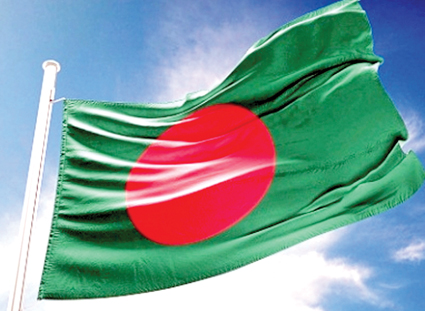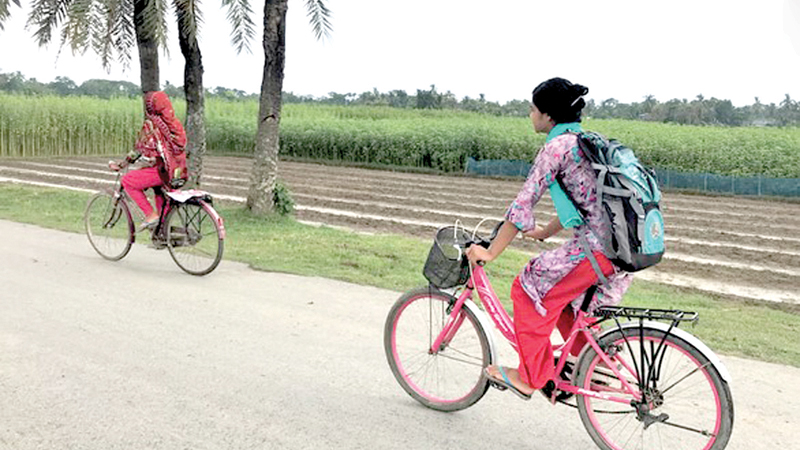Bangladesh, which was ‘East Bengal’ earlier, became a Muslim-majority area by a peaceful and gradual process from the 16th Century due to social, geographic and economic factors.
Initially, Islam came to North India riding on the back of the conquering armies of Muslim rulers from Arabia, Afghanistan, Iran and Central Asia from the Eighth to the 16th Century AD.
The aggressive propagation of the new faith had a great impact on North Western India (now Pakistan).It spread eastwards too, across North India. But its impact kept weakening as it travelled across the Gangetic plain, losing steam by the time it reached the borders of the present-day West Bengal State.
East Pakistan
Islam by-passed West Bengal only to implant itself in East Bengal. But the outreach to East Bengal was gradual and peaceful. Over time, East Bengal became a Muslim-majority area. The transformation was so thorough, that East Bengal joined the new Islamic State of Pakistan in 1947 to become its eastern wing called ‘East Pakistan’.
But the link with Pakistan was not to be permanent. Though tied to West Pakistan by Islam, economic, political and linguistic discrimination against East Pakistan led to the latter’s seceding and becoming ‘Bangladesh’ or the ‘Land of the Bengalis’ in 1971. Today, Bangladeshi Muslims constitute the world’s third-largest Muslim community and the largest Muslim community in South Asia.
Beginnings
Islam arrived in East Bengal in a small way in the 16 Century. It was not imposed by the sword or any pressure. A combination of social, economic, political and geographic factors over a long period of time led to the conversion. The process is traced by historian Prof. Richard M. Eaton of the Arizona State University in a seminal work on the history of Bengali Islam.
Eaton says that in the beginning, the Muslim population in East Bengal was small and confined to urban centres such as Dhaka. It mainly comprised non-Bengali Muslims such as Turks, Afghans and Moghuls. They were the rulers and soldiers, styling themselves as the elite ‘Ashraffs’. Indigenous Bengali Muslims were in the rural areas as cultivators and fishermen.
 The Afghans and Moghuls looked down upon agriculture and fishing as lowly and so looked down upon Bengali Muslims also. With noses up in the air, the foreigners did not even want to convert locals. Some Moghul rulers even punished officials for indulging in conversion.
The Afghans and Moghuls looked down upon agriculture and fishing as lowly and so looked down upon Bengali Muslims also. With noses up in the air, the foreigners did not even want to convert locals. Some Moghul rulers even punished officials for indulging in conversion.
But still, Islam spread among the Bengali peasantry. One of the reasons for this was that, unlike in West Bengal, East Bengal had not been influenced by rigid Brahminical Hindu beliefs and practices such as the caste system with its inequalities and taboos. Because East Bengal was heavily forested and very wet, it was sparsely populated and could not support agriculture and the caste system which grew out of settled agriculture. East Bengali society was egalitarian and so, it could absorb equalitarian Islam.
The other key factor was the Moghul rulers’ land and taxation policy for East Bengal. The rulers gave parcels of land, tax-free to ‘Pirs’ (indigenous local Islamic holy men) and also to some Hindus to cut the jungle and grow crops with the help of local recruits. The Pirs and Hindu recruiters were also told that they should build a temple or a mosque and maintain them from their agricultural earnings.The job given to the Pirs and the Hindu pioneers was onerous as East Bengal was heavily forested. When forests were cleared and agriculture grew, the grateful new cultivators deified the pioneer leaders as ‘Pirs’. So, Pirs became the agents of change.
The other agent of change was the change in the course of the river Ganges in the 16th Century. The Ganges linked up with the river Padma in East Bengal and opened the route to the West. Agriculture and trade grow as a result. With prosperity, piety grew and it was Islamic piety.
Legend of Sheikh Tabrizi
But East Bengali Islam was not the Turkic or Moghul Islam but indigenous and peasant-based, says Prof. Eaton. This is reflected in the Bengali Muslim legend of Shaikh Jalal al-Din Tabrizi, found in the 16 Century Bengali text Sekasubhodaya. The hero of Sekasubhodaya was not a Hindu deity but Shaikh Jalal al-Din Tabrizi a Muslim from West Asia. Tabrizi was instructed by Pradhana-purusa (‘Great Person,’ i.e., God) to go to ‘the Eastern country,’ where he would meet Raja Lakshmana Sena, in whose kingdom he would build a ‘House of God’ (Devasadana), or a mosque. The Shaikh did as he was told.
Walking on the Ganges River with his magical shoes, Shaikh Tabrizi reached the Senas’ capital in Padua and upon meeting Raja Lakshmana Sena, he challenged the king to cause a nearby heron to release a fish caught in its bill. When Lakshmana Sena declined, the Shaikh merely glanced at the bird which at once dropped the fish. The astonished king asked for the Shaikh’s grace (Prasad) and vowed to remain his steadfast devotee.
Shaikh Tabrizi then built a mosque. And after Lakshmana Sena donated some forest land for the purpose, the holyman cleared the area of demons and offered holy water to Pradhana-purusa (God or Allah) and to the Himalayas, held sacred by the Hindus. That done, Shaikh Tabrizi invited people to settle in that land and grow rice. The settlers turned to Islam in thankfulness and began to worship Shaikh Tabrizi as he had the ‘glow of penance,’ or Tapah Prabhab, the power acquired through the practice of ascetic austerities. The Shaikh’s patron deity, ‘Allah,’ was given the generic and portable name Pradhana-purusa, ‘Great Person’.
Nabi Bamsa
Sayid Sultan’s epic poem, the Nabi Bamsa, also composed in the 16 Century,sought to carve out a theological space for Islam in Bengali terms. The Nabi Bamsa treats the major deities of the Hindu pantheon, including Brahma, Vishnu, Siva, Rama and Krishna, as successive prophets of God, followed in turn by Adam, Noah, Abraham, Moses, Jesus and finally, Muhammad.
By commenting on Vedic, Vaishnava and Saiva divinities, in this way, the Nabi Bamsa fostered the claim that Islam was the heir, not only to Judaism and Christianity, but also to the religious traditions of pre-Muslim Hindu Bengal. Rather than repudiating those older religious traditions, Sayid Sultan’s epic served to connect Islam with Bengal’s Hindu socio-religious past, Prof. Eaton says.
The introduction of papermaking technology in the 15th Century and its use by Islamists, endowed the written word in the Quran, with great authority. As a result, Hinduism’s oral tradition dimmed in appeal. A ‘culture of literacy” began to spread among the Muslim gentry. It endowed the cult of Allah as found in the Quran with great authority, Prof. Eaton says.
However, all the while, the highly Sanskrit-based Bengali language was never abandoned by Muslims in Bengal, including the foreign origin Ashraffs. With the Bengali language came a culture and concepts which marked Bengali Muslims from the Turks, Afghans and Moghuls. Even today, after four centuries of Islamisation and a period as part of Pakistan, Bengali Muslims have a lot that is pre-Muslim as part of their lives.
But in the 18th and 19th Centuries, Bengali Muslims, both landlords and peasants lost out to the Hindus as a result of land and taxation policies of the British rulers called the ‘Permanent Settlement’. Dhaka also lost out to Calcutta as the British made Calcutta the capital of Bengal. These triggered a movement to ‘West Asianise’ Bengali Islam and deny its Hindu heritage. Some leading Bengali Muslims even went to the extent of saying that they were not converts but Moghul migrants from North India and West Asia.
‘Moghul blood’
Henry Beverly, who conducted the 1872 census, wrote that the existence of Muslims in Bengal was not due to the introduction of ‘Moghul blood’ into the country but to the conversion of the former inhabitants for whom a rigid system of caste discipline rendered Hinduism intolerable.
But this theory evoked stiff opposition from the Bengali Muslim leaders of the day.
A leading Muslim of Mymensingh District, Abu A. Ghuznavi, submitted a report to the Collector of his district strenuously opposing Beverley’s argument. Ghuznavi asserted that “the majority of the modern Mohomedans are not the descendants of Chandals and Kaibartas(low caste Hindus) but are of foreign extraction.”
Ghuznavi cited as reasons for his argument the following points: Arab migration before the Turkish conquest, land grants made by Sultan Husain Shah to foreigners, the dispersion of Afghans “in every hamlet” after the Moghul conquest, the greater fertility of Muslims owing to their practices of polygamy and widow remarriage, their greater longevity and the absence of a caste system and institutionalised celibacy.
Bangladeshi nationalism
However, given the rise of a strong ‘Bangladeshi’ nationalism since 1971, Ghuznavi’s theory does not find favour now. Links to the Hindu heritage or culture are not rejected as undesirable by Bangladeshis. In other words, Bangladeshi are not only Muslims but Bengali Muslims to be precise.




